13 Best Moral Story in English for Kids
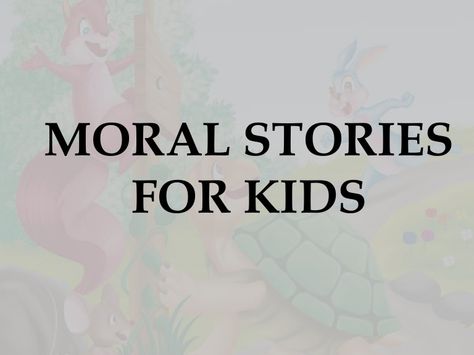
1. The Eagle and the Fox
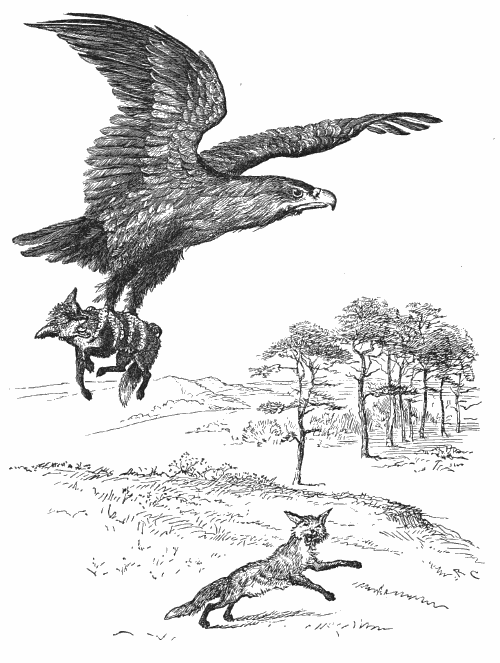
Once upon a time, there was a great eagle that soared high above the forest, surveying his kingdom from above. He was the mightiest of all the birds and he ruled over the skies with grace and strength.
One day, while flying over the forest, the eagle spotted a clever little fox darting through the trees below. The fox was small and nimble, but he was quick-witted and full of cunning.
The eagle was impressed by the fox’s intelligence and decided to swoop down to get a closer look. The fox saw the eagle descending and quickly realized that he was in danger. He had heard stories of the eagle’s fierce talons and razor-sharp beak, and he knew that he wouldn’t stand a chance in a fight.
But the fox was too clever to be caught so easily. As the eagle approached, the fox darted to the side, causing the eagle to miss his mark. The eagle was surprised by the fox’s agility and decided to pursue him, determined to capture the clever creature.
For hours, the eagle chased the fox through the forest, but the fox always managed to stay just out of reach. The eagle grew more and more frustrated, unable to understand how such a small creature could be so elusive.
Finally, the eagle decided to call off the chase. He flew back up into the sky, defeated and humbled by the fox’s quick thinking and agility. As he soared back to his perch, he realized that sometimes even the mightiest of creatures can learn something from those smaller and cleverer than themselves.
And so, the eagle and the fox continued to coexist in the forest, each respecting the other’s unique strengths and abilities. The eagle had learned a valuable lesson about the power of cunning and quick thinking, and the fox continued to thrive in the forest, using his wits to survive and thrive.
2. A Wise Old Owl Story

Once upon a time, in a deep, dark forest, there lived a wise old owl. He was known throughout the land for his great wisdom and his ability to see in the dark.
One night, a young rabbit came to the owl seeking his advice. The rabbit was afraid of the dark and was having trouble sleeping at night. He asked the owl how he was able to see in the dark and how he stayed so wise and knowledgeable.
The wise old owl replied, “It is true that I can see in the dark, but that is not what makes me wise. Wisdom comes from experience, from learning, and from listening to the world around you. It is not something that you can simply acquire, but something that you must work for and earn.”
The rabbit was intrigued and asked the owl to teach him how to become wise. The owl agreed and began to impart his knowledge to the young rabbit.
He taught the rabbit about the different plants and animals in the forest and how they all interacted with each other. He taught him about the changing seasons and the cycles of life and death. He taught him about the importance of listening to the world around him and the value of patience and perseverance.
Over time, the young rabbit grew wiser and more knowledgeable, and he became more confident and sure of himself. He learned to navigate the dark forest and to face his fears, and he became a respected member of the animal kingdom.
And so, the wise old owl and the young rabbit continued to share their knowledge and experience with each other, passing down the lessons of the forest to the generations that would follow. For it is said that wisdom is like a flame that can be passed from one person to another, lighting the way for those who seek it.
3. Three Little Pigs
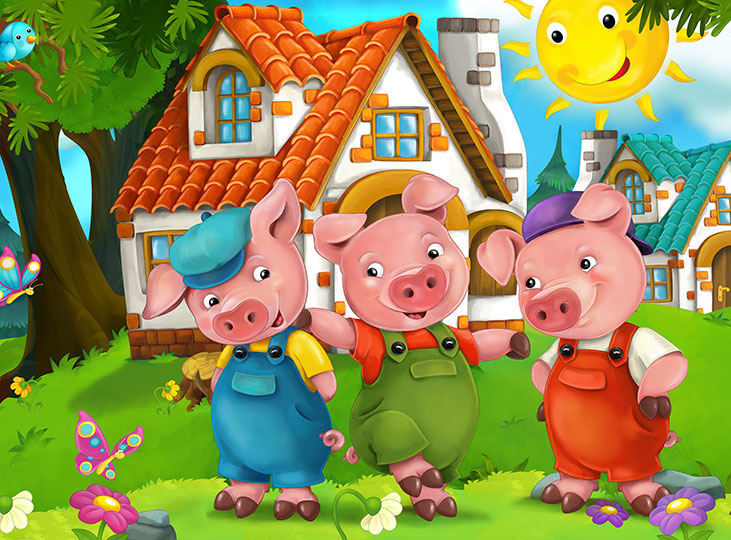
Once upon a time, there were three little pigs who left their home to build houses of their own. The first little pig built his house out of straw, the second little pig built his house out of sticks, and the third little pig built his house out of bricks.
One day, a big, bad wolf came to the first little pig’s house and said, “Little pig, little pig, let me come in.” But the little pig said, “No, no, not by the hair on my chinny chin chin.” So the wolf huffed and he puffed and he blew the straw house down.
The first little pig ran to his brother’s house made of sticks. But the wolf followed him there and said, “Little pigs, little pigs, let me come in.” But the two little pigs said, “No, no, not by the hair on our chinny chin chins.” So the wolf huffed and he puffed and he blew the stick house down.
The two little pigs ran to their brother’s house made of bricks. The wolf followed them there and said, “Little pigs, little pigs, let me come in.” But the three little pigs said, “No, no, not by the hair on our chinny chin chins.” So the wolf huffed and he puffed, but he could not blow the brick house down.
The wolf was angry and he tried to find a way to get inside the brick house. He climbed onto the roof and tried to come down the chimney, but the clever little pigs had a plan. They lit a fire in the fireplace, and when the wolf came down, he fell right into the fire and ran away howling in pain.
From that day on, the three little pigs lived happily in their brick house, safe and sound from the big, bad wolf. They realized that it was important to work hard and be smart, and to always have a good plan to keep themselves safe. And they knew that they could overcome any obstacle as long as they worked together and were clever in their ways.
4. The Princess And The Pea Story
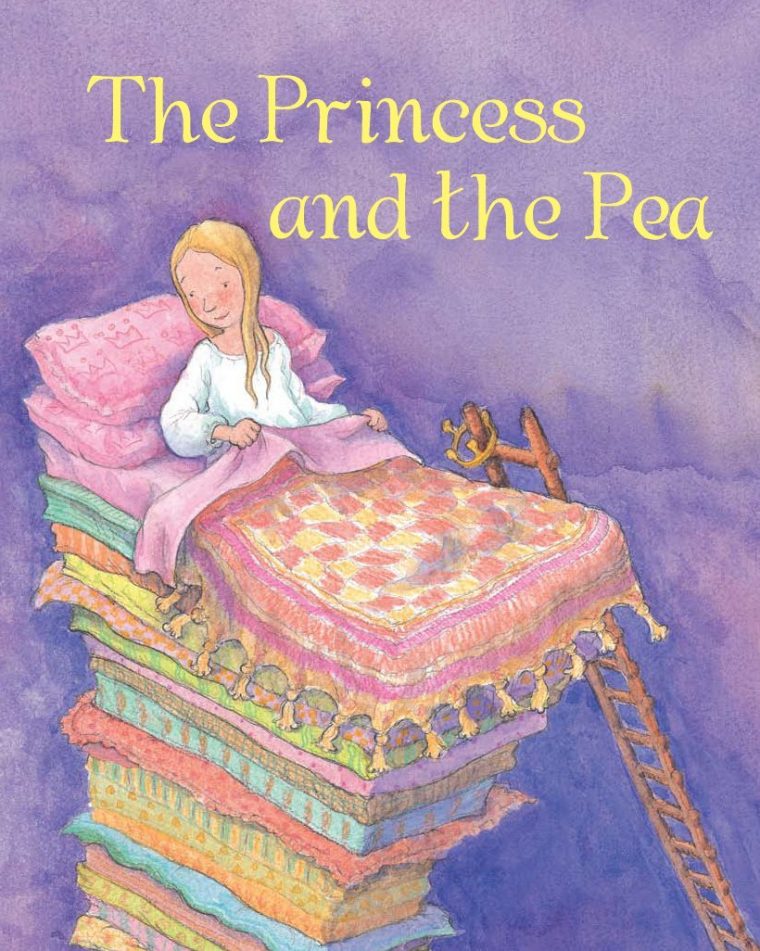
Once upon a time, there was a prince who wanted to find a princess to marry. He searched far and wide but he could not find a princess who was worthy of him.
One stormy night, a young woman knocked on the palace gates, claiming to be a princess. She was wet, tired and had traveled a long way in the storm. The prince was delighted at the prospect of having a true princess to marry and welcomed her into the palace.
The queen, however, was not convinced that the young woman was a real princess. She devised a test to see if she was truly royalty. The queen prepared a bed for the young woman with 20 mattresses piled on top of each other, and then placed a single pea on the very bottom mattress. The young woman was then invited to sleep in the bed for the night.
The next morning, the queen asked the young woman how she slept. The princess replied that she had not slept well at all, as she had been kept awake by a lump in the bed. The queen was overjoyed, knowing that only a true princess could feel a pea through such a large pile of mattresses.
The prince was delighted to have found a true princess and he asked her to marry him. The young woman said yes, and the prince and the princess were married in a grand ceremony. From that day forward, the young woman was treated with the utmost respect and dignity, as a true princess should be.
And so, the prince and princess lived happily ever after, with the knowledge that they had found true love and that nothing, not even a tiny pea, could keep them apart.
5. The Ants and the Elephant

Once upon a time, in a jungle, a group of ants was busy gathering food for the winter. They worked hard all day long, carrying food back to their colony, but they often had to travel long distances to find enough food.
One day, they saw a huge elephant walking towards them. The ants were terrified and scattered in all directions. But to their surprise, the elephant stopped and looked down at them.
The ants begged for mercy and asked the elephant not to harm them. The elephant smiled and said, “Do not be afraid, little ants. I am not here to harm you. I am just passing through your territory.”
The ants were relieved and one of them said, “Oh great elephant, we are small and weak. We have to work hard every day to gather food for the winter. Could you please help us by carrying some of our food back to our colony?”
The elephant felt sorry for the ants and agreed to help them. The ants then climbed up onto the elephant’s back and directed him to their colony. The elephant walked slowly and carefully, not to harm the tiny ants.
When they reached the ant colony, the ants were grateful to the elephant and gave him some food as a thank you. The elephant was pleased and said, “From now on, I will always be happy to help you, little ants.”
And so, the elephant and the ants became friends. The elephant helped the ants by carrying their food, and the ants thanked him by providing him with food and shelter. They learned that even though they were different in size and strength, they could still help each other and be good friends.
The moral of the story is that true friendship does not depend on size, strength, or appearance. It is based on kindness, mutual respect, and a willingness to help each other.
6. The Poor Slave and the Lion
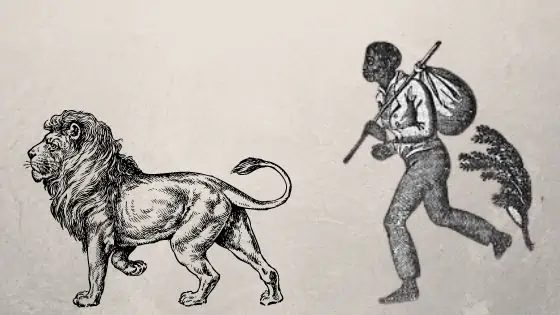
Once upon a time, there was a poor slave who was forced to work for his cruel master day and night. One day, while working in the fields, he stumbled upon a lion that was caught in a trap. The lion was in great pain and was unable to free itself.
The slave, who had a kind heart, approached the lion cautiously and saw that it was suffering greatly. Despite the danger, he decided to help the lion and freed it from the trap. To his surprise, the lion did not attack him, but instead, it licked his hands and nuzzled him with its head.
The slave was amazed at the lion’s reaction and realized that he had made a new friend. From that day forward, the lion followed the slave around everywhere he went. The slave would share his meager food with the lion and take care of it as best he could.
One day, the slave’s cruel master found out about the lion and ordered him to kill it. The slave begged his master not to harm his friend, but the master did not listen. The slave had no choice but to take the lion deep into the forest, far away from his master’s reach.
The slave and the lion lived in the forest for many years. The lion would hunt for food and protect the slave from other wild animals. The slave would share his food and talk to the lion, and they became the best of friends.
One day, while the slave and the lion were out hunting for food, they stumbled upon the slave’s old master who was lost in the forest. The master was scared and begged the slave to save him from the wild animals.
The slave remembered how his old master had treated him and his friend, the lion, but he decided to forgive him. He ordered the lion to protect the master, and the lion did just that. The lion protected the master from harm and escorted him out of the forest.
From that day on, the slave and the lion continued to live in the forest, happy and content, knowing that true friendship can overcome even the most difficult challenges.
The moral of the story is that true friendship is based on kindness, love, and forgiveness. It does not matter where you come from or who you are, what matters is how you treat others and how you are willing to help those in need.
7. The Ugly Duckling
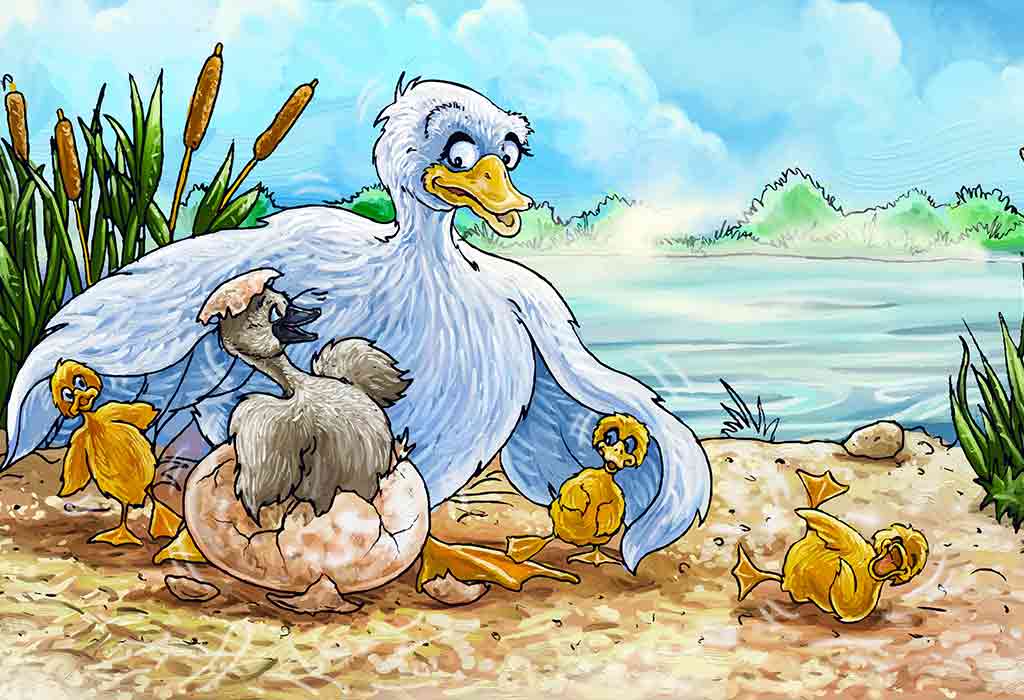
Once upon a time, on a farm in a peaceful countryside, a mother duck hatched her eggs. However, one of the eggs was much larger than the others, and when it hatched, a strange-looking duckling emerged. He was so different from the other cute and fluffy ducklings that everyone laughed at him and called him the “Ugly Duckling”.
The Ugly Duckling was very unhappy and felt lonely. His brothers and sisters didn’t want to play with him, and even the other animals in the farm would make fun of him. He felt like he didn’t belong anywhere and decided to leave the farm.
As he went on his way, he encountered other animals, but none of them accepted him for who he was. He wandered through the fields, over hills, and across valleys until he came across a pond. When he looked into the water, he saw a reflection of himself and realized he was not a duck at all, but a swan.
The swans in the pond were amazed by the beauty of the Ugly Duckling and welcomed him with open wings. The Ugly Duckling was surprised that he was not a duck but a beautiful swan. He felt happy and content at last, and soon he forgot about his sad past.
Years passed, and the Ugly Duckling grew into a magnificent swan. One day, he saw a family of ducks swimming in the pond and recognized them as his own family. He was overjoyed to see them, but the ducks didn’t recognize him and even chased him away. The Ugly Duckling realized that his family didn’t accept him before because he was different, but he was proud of who he was now and didn’t need their acceptance anymore.
The Ugly Duckling lived happily ever after with his swan friends, who loved him for who he was, not for what he looked like. He learned that true beauty is not about appearance, but about what’s inside, and that sometimes, being different is what makes you special.
The moral of the story is that we should never judge someone by their appearance or make fun of them just because they are different. We should accept and respect each other’s differences and celebrate them, as it’s what makes us unique and special.
8. The Thirsty Crow
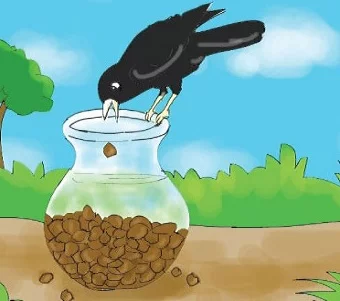
Once upon a time, a thirsty crow was flying over a hot and dry land in search of water. He looked around but couldn’t find any source of water. After a while, he saw a pitcher on the ground, but it had only a little bit of water left in it, and the crow couldn’t reach it with his beak.
The crow thought for a while and then got an idea. He picked up small pebbles and started dropping them into the pitcher. The water level started rising, and after a few pebbles, the water came up high enough for the crow to take a sip.
The crow drank the water and quenched his thirst, and he felt happy and content. He then flew away, feeling proud of his intelligence and problem-solving skills.
The moral of the story is that intelligence and creativity can help you overcome even the toughest of problems. It’s important to think outside the box and come up with innovative solutions to solve our problems.
9. The Dog and The Bone

Once upon a time, a stray dog was wandering around a market in search of food. He was feeling hungry and tired when he saw a delicious-looking bone lying on the ground.
The dog immediately picked up the bone and started chewing on it. As he was enjoying the bone, he saw his own reflection in a nearby pond. Mistaking it for another dog with another bone, he became greedy and thought he should have that bone too.
So, he started barking at his own reflection, hoping to scare the other dog away and get the second bone. However, as he kept barking, the bone in his mouth fell into the pond, and he was left with nothing.
The dog realized his mistake and felt foolish for his greed. He had lost the bone he had, and there was no other bone or food in sight. He went away, regretting his actions and hoping to learn from his mistake.
The moral of the story is that greed often leads to loss. Sometimes, it’s better to be content with what we have and not to be greedy for more. We should be grateful for the blessings we have and not let our desires lead us to make foolish decisions.
10. The Midas Touch
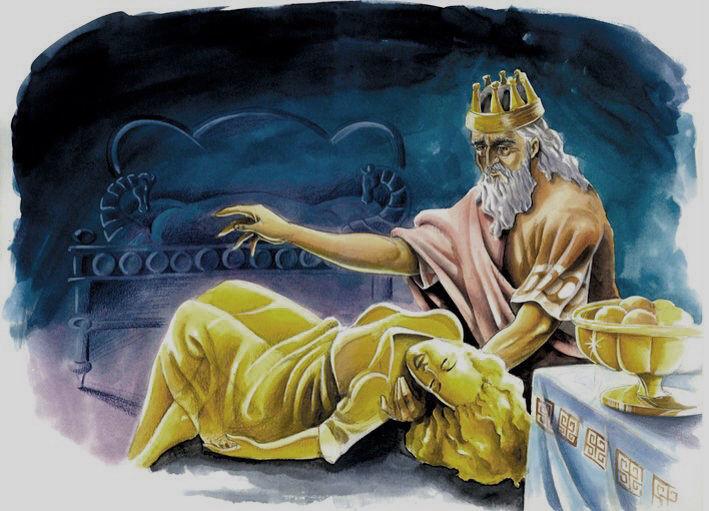
The story of the Midas Touch is a famous Greek myth about a king named Midas who had a unique gift for turning everything he touched into gold.
One day, a drunken old man wandered into Midas’s court and fell asleep. When he woke up, the old man introduced himself as the god Dionysus and offered to grant Midas any wish he desired. Midas, who loved gold above all else, wished that everything he touched would turn to gold.
At first, Midas was delighted with his newfound gift, as he could turn anything he wanted into gold. But soon, he realized that his gift was a curse, as everything he touched turned to gold, including his food and even his daughter. Midas realized that his love for gold was not worth the pain and misery he was causing himself and others.
Desperate to be rid of his curse, Midas begged Dionysus to take back his gift. Dionysus told Midas to bathe in the river Pactolus, and his gift would be removed. Midas did as he was instructed, and when he emerged from the river, his curse was lifted, and he was once again a mortal man.
From then on, Midas lived a humble life, and he learned the lesson that wealth cannot bring true happiness.
The moral of the story is that greed can lead to misery, and that material possessions cannot bring true happiness. We should be careful about what we wish for and be content with what we have.
11. The Musical Donkey
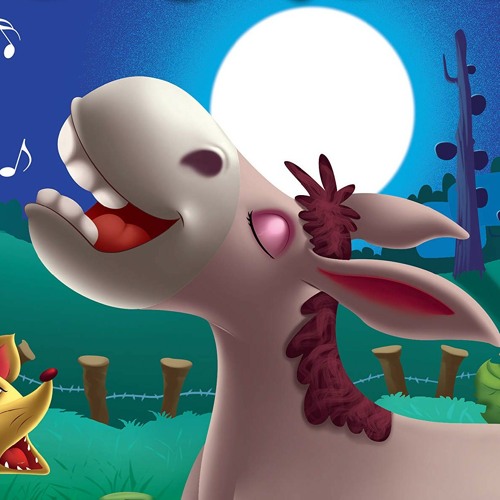
Once upon a time, there was a donkey who lived in a small village. He was an ordinary donkey and had no special skills, but he had a love for music and enjoyed hearing the sounds of the village musicians as they played their instruments.
One day, the village was preparing for a big festival, and the musicians were practicing for the event. The donkey, who was listening intently, was inspired and decided to join in on the music-making. He started to bray, trying to match the rhythm and melody of the instruments.
To the surprise of everyone, the donkey’s braying was in tune, and it sounded like he was singing. The musicians were amazed and quickly invited the donkey to join their band. The donkey was overjoyed, and he became the star of the band, performing at the festival and other events in the village.
As the years went by, the donkey became famous throughout the land for his musical talent. He continued to perform with the band and brought happiness to many people who enjoyed listening to his music.
The moral of the story is that everyone has a talent or skill that they can offer to the world. Even if we think we are ordinary, we can discover something that we are good at and bring joy to others. We should always be open to exploring our interests and talents and be willing to share them with others.
12. The Clever Monkey
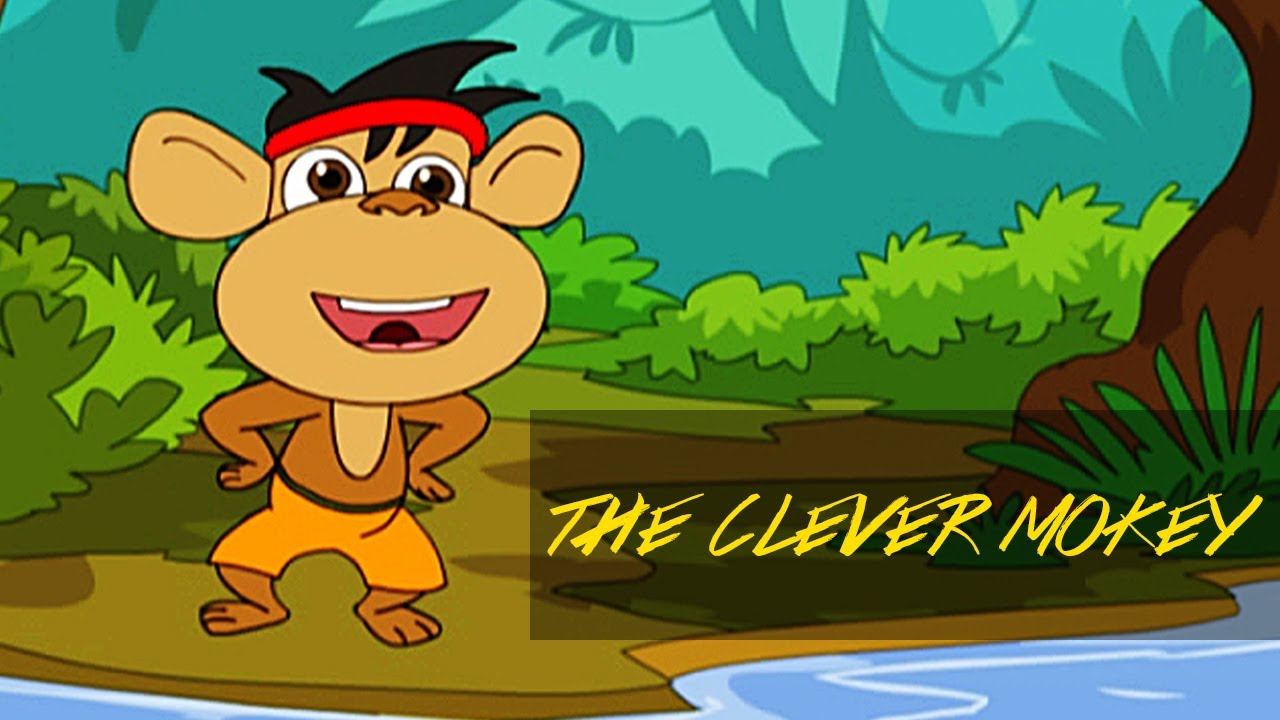
Once upon a time, in a dense forest, a clever monkey lived on a tall tree. The monkey was known throughout the forest for his wit and intelligence. One day, while the monkey was relaxing on a branch, he saw a hunter setting up a trap on the forest floor.
The monkey was worried that the trap was meant to catch him, so he decided to investigate. The monkey saw that the trap was indeed meant for him and that it was a very clever trap. The trap consisted of a pit, covered with leaves and twigs, with a banana placed in the center to lure the monkey.
The monkey knew that he had to outsmart the hunter and his trap. He came up with a plan and waited for the hunter to leave. Once the hunter was gone, the monkey picked up a stone and threw it at the banana. The banana fell into the pit, and the monkey climbed down the tree to get it.
But as he got closer to the trap, the monkey realized that he had been too clever for his own good. The walls of the pit were too high for him to climb, and he was trapped.
The monkey thought for a moment and then decided to use his wit to escape. He waited for some time, and then he saw a group of other monkeys passing by. The clever monkey called out to them for help, and the other monkeys soon came to his aid. They formed a chain, and the clever monkey climbed on their backs and made his way out of the pit.
The hunter returned to find the trap empty and was amazed at how the monkey had outsmarted him. He realized that he had underestimated the intelligence of the monkey and decided to leave him alone.
The clever monkey went back to his tree, grateful for the help of his friends and proud of his own wit.
The moral of the story is that intelligence and wit can help us overcome even the most challenging situations. We should always use our brains and be resourceful in finding solutions to our problems. And we should also remember to be kind to others, as they may be the ones to help us in our time of need.
13. An Old Man Lived within the Village
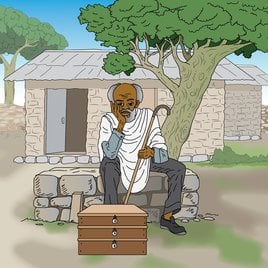
Once upon a time, in a small village, there lived an old man who was well-respected by all the villagers. The old man had lived in the village for many years, and everyone knew him as a kind and wise person who had helped many people over the years.
The old man lived alone in a small house, and despite his age, he was very active and always busy doing something. Every day, he would go for a walk in the forest or work in his garden, and he was always willing to help anyone who needed it.
One day, a group of young boys from the village saw the old man working in his garden and decided to play a trick on him. They sneaked into his garden and started to pull out all the plants and flowers that the old man had been carefully growing.
The old man saw what was happening and tried to stop the boys, but they just laughed and continued to destroy his garden. The old man was heartbroken to see all his hard work destroyed, and he felt helpless against the young boys.
But instead of getting angry, the old man decided to teach the boys a lesson. The next day, he invited the boys to his house and offered them some food and drinks. The boys were surprised by the old man’s kindness and accepted the invitation.
As the boys ate and drank, the old man told them stories about his own childhood and the lessons he had learned over the years. The boys listened intently, and by the end of the day, they had come to admire the old man for his wisdom and kindness.
From that day on, the boys became the old man’s helpers in his garden, and they worked hard to help him restore the beautiful plants and flowers that had been destroyed. The old man forgave the boys and showed them that kindness and understanding can overcome even the most hurtful actions.
The moral of the story is that forgiveness and kindness can help to heal even the deepest wounds. When we face challenges, it’s important to remember that we have the power to choose how we react. And by responding with compassion and understanding, we can turn difficult situations into opportunities for growth and learning.
2 thoughts on “13 Best Moral Story in English for Kids”